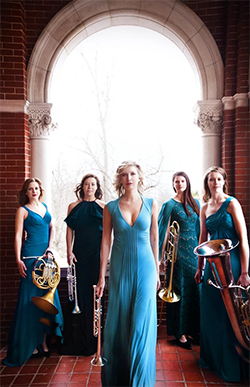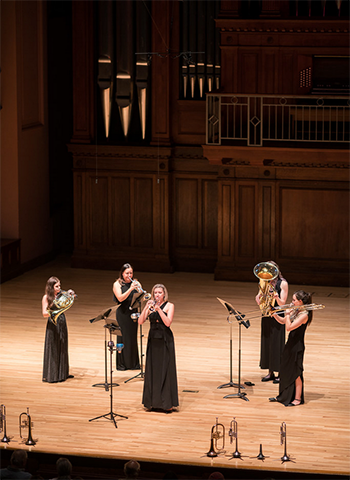by Daniel Hathaway

In brassology, “Seraph” denominates an all-female brass organization, now in its 10th year, whose playing embraces all those astral virtues, plus impressive stamina, breathtaking virtuosity, and an engaging sense of showmanship.
Although angels are traditionally genderless, Seraph Brass was established “with a mission to showcase the excellence of female brass players and highlight musicians from marginalized groups, both in personnel and in programming.”
Performing in their usual configuration as a quintet, Seraph founder and trumpeter Mary Elizabeth Bowden, trumpeter Raquel Samayoa, hornist Rachel Velvikis, trombonist Elisabeth Shafer, and tubist Robyn Black recently visited Oberlin to give master classes, hold a lunch conversation, and play an evening performance on Friday, October 13.
After a two-year COVID hiatus, the ensemble heralded a new season of Oberlin’s Artist Recital Series in Finney Chapel with excellent performances of wide-ranging selections from the Great American Brass Quintet Book. They cannily avoided playing entire works in favor of assembling an entertaining, fast-paced evening of music whose more sophisticated entries were leavened with surefire crowd pleasers.
Seraph immediately grabbed attention with their signature opener, the Prelude from Grieg’s Holberg Suite, flawlessly tossed off from memory at a brisk tempo, then turned to Verdi’s “Sempre Libera” from La traviata, with Bowden taking the role of Violetta in expressive, diva-worthy melismas. Then Bolivar featured Shafer in her own arrangement of British-Australian composer Erik Cook’s dazzling trombone showpiece.
Oberlin horn professor Jeff Scott, formerly of the Imani Winds, responded to Seraph’s invitation for a commission with Showcase, a substantial work that allowed the quintet to demonstrate their collective talents. A rhythmically complex opening movement with a recurring downward scale motif leads to a calmer slow section loaded with solos. Wound up again, the piece ends in a sudden valedictory gesture. Scott was on hand to take a bow during the warm ovation for his new work.

The second half featured a parade of shorter works, including Lillian Yee’s Miracles of the Human Condition, Tim Olt’s arrangement of Dinicu’s famous Hora Staccato, the third movement from Reena Esmail’s Khirkiyaan (Windows): Three Transformations for Brass Quintet, Catherine McMichael’s Virgo, the Lover of Justice, and Anthony DiLorenzo’s Go! (full of meter changes and dedicated to the late trombonist Steve Witzer), giving the quintet various opportunities to explore double-tonguing and luxuriate in solos, including one by Bowden on flugelhorn.
Obviously enjoying itself, the audience wasn’t about to let Seraph go without a bonus work. Whether its first few notes conjured images of victorious Swiss soldiers or the Lone Ranger and Tonto, the finale of Rossini’s William Tell Overture was a fun way to end a splendid evening.
Published on ClevelandClassical.com October 24, 2023.
Click here for a printable copy of this article



